Damage Detection in Beam Bridges Using Quasi-static Displacement Influence Lines
Abstract
:1. Introduction
2. Damage Detection Using the Quasi-static Displacement Influence Lines of Bridges
2.1. Generation of the Quasi-static Displacement Influence Lines of Actual Bridges
2.2. Damage Detection Using the Null Space Method Based on Quasi-static Displacement Influence Lines
2.2.1. Hankel Matrix of the Damage Feature Established with Quasi-static Displacement ILs
2.2.2. Metric for Evaluating the Damage Feature
2.2.3. Discussion of the Quasi-static Loading Conditions Before and After Damage
2.2.4. Procedure of the Proposed Method
3. Numerical Example
3.1. Brief Description of the Numerical Example
3.2. Damage Detection Performance of the Proposed Method
3.3. Comparison of the Performance Between the Proposed Method and the Traditional Approach
3.3.1. Damage Detection Without the Effect of Measurement Noise
3.3.2. Damage Detection Considering the Effect of Measurement Noise
3.3.3. Damage Detection Considering Different Loading Conditions before and after Damage
3.3.4. Robust Performance of the Proposed Method
4. Experimental Example
4.1. Brief Description of the Model Bridge
4.2. Introduction of Sensor Placement and Damage Cases
4.3. Comparison of the Experimental Results Between the Proposed Method and the Traditional Method
4.3.1. Results with the Same Loading Conditions before and after Damage
4.3.2. Results with Different Loading Conditions Before and After Damage
5. Conclusions
Author Contributions
Funding
Conflicts of Interest
References
- Kong, X.; Cai, C.S.; Hu, J. The state-of-the-art on framework of vibration-based structural damage identification for decision making. Appl. Sci. 2017, 7, 497. [Google Scholar] [CrossRef]
- Moughty, J.J.; Casas, J.R. A state of the art review of modal-based damage detection in bridges: Development, challenges, and solutions. Appl. Sci. 2017, 7, 510. [Google Scholar] [CrossRef]
- Cao, M.S.; Ding, Y.J.; Ren, W.X.; Wang, Q.; Ragulskis, M.; Ding, Z.C. Hierarchical wavelet-aided neural intelligent identification of structural damage in noisy conditions. Appl. Sci. 2017, 7, 391. [Google Scholar] [CrossRef]
- Zhao, H.; Uddin, N.; O’Brien, E.J.; Shao, X.D.; Zhu, P. Identification of vehicular axle weights with a Bridge Weigh-in-Motion system considering transverse distribution of wheel loads. ASCE J. Bridge Eng. 2014, 19, 165–184. [Google Scholar] [CrossRef]
- Wang, X.; Hu, N.; Fukunaga, H.; Yao, Z.H. Structural damage identification using static test data and changes in frequencies. Eng. Struct. 2001, 23, 610–621. [Google Scholar] [CrossRef]
- Banan, M.R.; Banan, M.R.; Hjelmstad, K.D. Parameter estimation of structures from static response. I: Computational aspects. J. Struct. Eng. 1994, 120, 3243–3258. [Google Scholar] [CrossRef]
- Banan, M.R.; Banan, M.R.; Hjelmstad, K.D. Parameter estimation of structures from static response. II: Numerical simulation studies. J. Struct. Eng. 1994, 120, 3259–3283. [Google Scholar] [CrossRef]
- Abdo, M.A.B. Parametric study of using only static response in structural damage detection. Eng. Struct. 2012, 34, 124–131. [Google Scholar] [CrossRef]
- Guo, T.; Li, A.Q.; Song, Y.S.; Zhang, B.; Liu, Y.; Yu, N.S. Experimental study on strain and deformation monitoring of reinforced concrete structures using PPP-BOTDA. Sci. China Ser. E Technol. Sci. 2009, 52, 2859–2868. [Google Scholar] [CrossRef]
- Yang, Q.W. A new damage identification method based on structural flexibility disassembly. J. Vib. Control 2011, 17, 1000–1008. [Google Scholar] [CrossRef]
- Yang, Q.W.; Liu, J.K. Damage identification by the eigenparameter decomposition of structural flexibility change. Int. J. Numer. Methods Eng. 2009, 78, 444–459. [Google Scholar] [CrossRef]
- Choi, I.Y.; Lee, J.S.; Choi, E.; Cho, N.H. Development of elastic damage load theorem for damage detection in a statically determinate beam. Comput. Struct. 2004, 82, 2483–2492. [Google Scholar] [CrossRef]
- Wang, C.Y.; Huang, C.K.; Chen, C.S. Damage assessment of beam by a quasi-static moving vehicular load. Adv. Adapt. Data Anal. 2011, 3, 417–445. [Google Scholar] [CrossRef]
- Grandić, I.Š.; Grandić, D.; Bjelanović, A. Comparison of techniques for damage identification based on influence line approach. Mach. Technol. Mater. 2011, 7, 9–13. [Google Scholar]
- Štimac, I.; Mihanović, A.; Kožar, I. Damage detection from analysis of displacement influence lines. In Proceedings of the International Conference on Bridges, Dubrovnik, Croatia, 21–24 May 2006; pp. 1001–1008. [Google Scholar]
- Chen, Z.W.; Zhu, S.; Xu, Y.L.; Li, Q.; Cai, Q.L. Damage detection in long suspension bridges using stress influence lines. J. Bridge Eng. 2014, 20, 05014013. [Google Scholar] [CrossRef]
- Zeinali, Y.; Story, B.A. Impairment localization and quantification using noisy static deformation influence lines and Iterative Multi-parameter Tikhonov Regularization. Mech. Syst. Signal Process. 2018, 109, 399–419. [Google Scholar] [CrossRef]
- Zeinali, Y.; Story, B.A. Framework for Flexural Rigidity Estimation in Euler-Bernoulli Beams Using Deformation Influence Lines. Infrastructures 2017, 2, 23. [Google Scholar] [CrossRef]
- Zaurin, R.; Catbas, F.N. Integration of computer imaging and sensor data for structural health monitoring of bridges. Smart Mater. Struct. 2009, 19, 1–15. [Google Scholar] [CrossRef]
- Zaurin, R.; Catbas, F.N. Structural health monitoring using video stream, influence lines, and statistical analysis. Struct. Health Monit. 2011, 10, 309–332. [Google Scholar] [CrossRef]
- He, W.Y.; Ren, W.X.; Zhu, S. Damage detection of beam structures using quasi-static moving load induced displacement response. Eng. Struct. 2017, 145, 70–82. [Google Scholar] [CrossRef]
- He, W.Y.; Zhu, S. Moving load-induced response of a damaged simply-supported beam and its application in damage localization. J. Vib. Control 2016, 22, 3601–3617. [Google Scholar] [CrossRef]
- He, W.Y.; Ren, W.X.; Zhu, S. Baseline-free damage localization method for statically determinate beam structures using dual-type response induced by quasi-static moving load. J. Sound Vib. 2017, 400, 58–70. [Google Scholar] [CrossRef]
- Cavadas, F.; Smith, I.F.C.; Figueiras, J. Damage detection using data-driven methods applied to moving-load responses. Mech. Syst. Signal Process. 2013, 39, 409–425. [Google Scholar] [CrossRef] [Green Version]
- Liu, Y.; Zhang, S. Damage Localization of Beam Bridges Using Quasi-Static Strain Influence Lines Based on the BOTDA Technique. Sensors 2018, 18, 4446. [Google Scholar] [CrossRef]
- Chen, Z.; Li, Q.; Ansari, F.; Mendez, A. Serial multiplexing of optical fibers for sensing of structural strains. J. Struct. Control 2000, 7, 103–117. [Google Scholar] [CrossRef]
- Bao, X.; DeMerchant, M.; Brown, A.; Bremner, T. Tensile and compressive strain measurement in the lab and field with the distributed Brillouin scattering sensor. J. Lightwave Technol. 2001, 19, 1698–1704. [Google Scholar]
- Kaloop, M.; Hu, J.; Elbeltagi, E. Evaluation of high-speed railway bridges based on a nondestructive monitoring system. Appl. Sci. 2016, 6, 24. [Google Scholar] [CrossRef]
- Kong, Q.; Robert, R.; Silva, P.; Mo, Y. Cyclic crack monitoring of a reinforced concrete column under simulated pseudo-dynamic loading using piezoceramic-based smart aggregates. Appl. Sci. 2016, 6, 341. [Google Scholar] [CrossRef]
- Kordestani, H.; Xiang, Y.Q.; Ye, X.W.; Jia, Y.K. Application of the random decrement technique in damage detection under moving load. Appl. Sci. 2018, 8, 753. [Google Scholar] [CrossRef]
- Markou, M.; Singh, S. Novelty detection: A review-part 1: Statistical approaches. Signal Process. 2003, 83, 2481–2497. [Google Scholar] [CrossRef]
- Pimentel, M.A.F. A review of novelty detection. Signal Process. 2014, 99, 215–249. [Google Scholar] [CrossRef]
- Surace, C.; Worden, K. Novelty detection in a changing environment: A negative selection approach. Mech. Syst. Signal Process. 2010, 24, 1114–1128. [Google Scholar] [CrossRef]
- Worden, K.; Sohn, H.; Farrar, C.R. Novelty detection in a changing environment: Regression and interpolation approaches. J. Sound Vib. 2002, 258, 741–761. [Google Scholar] [CrossRef]
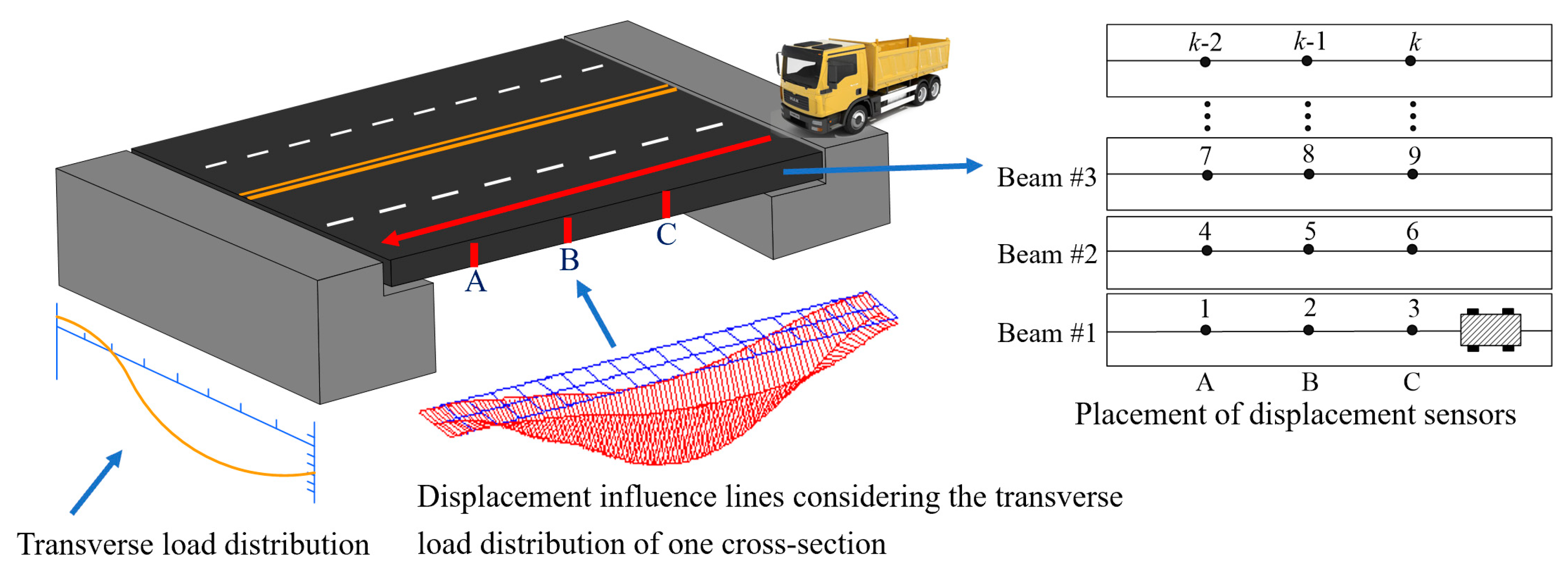
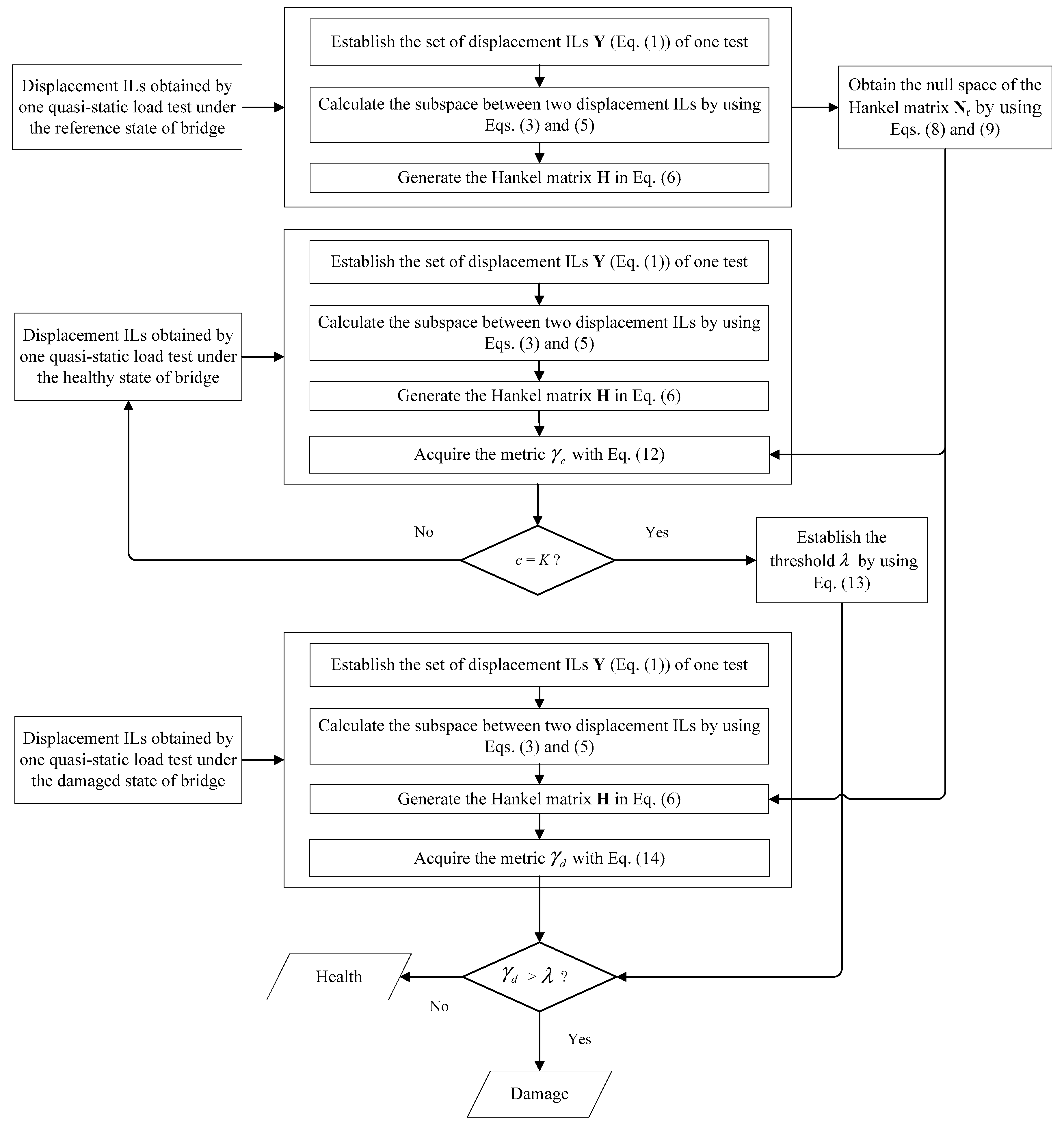

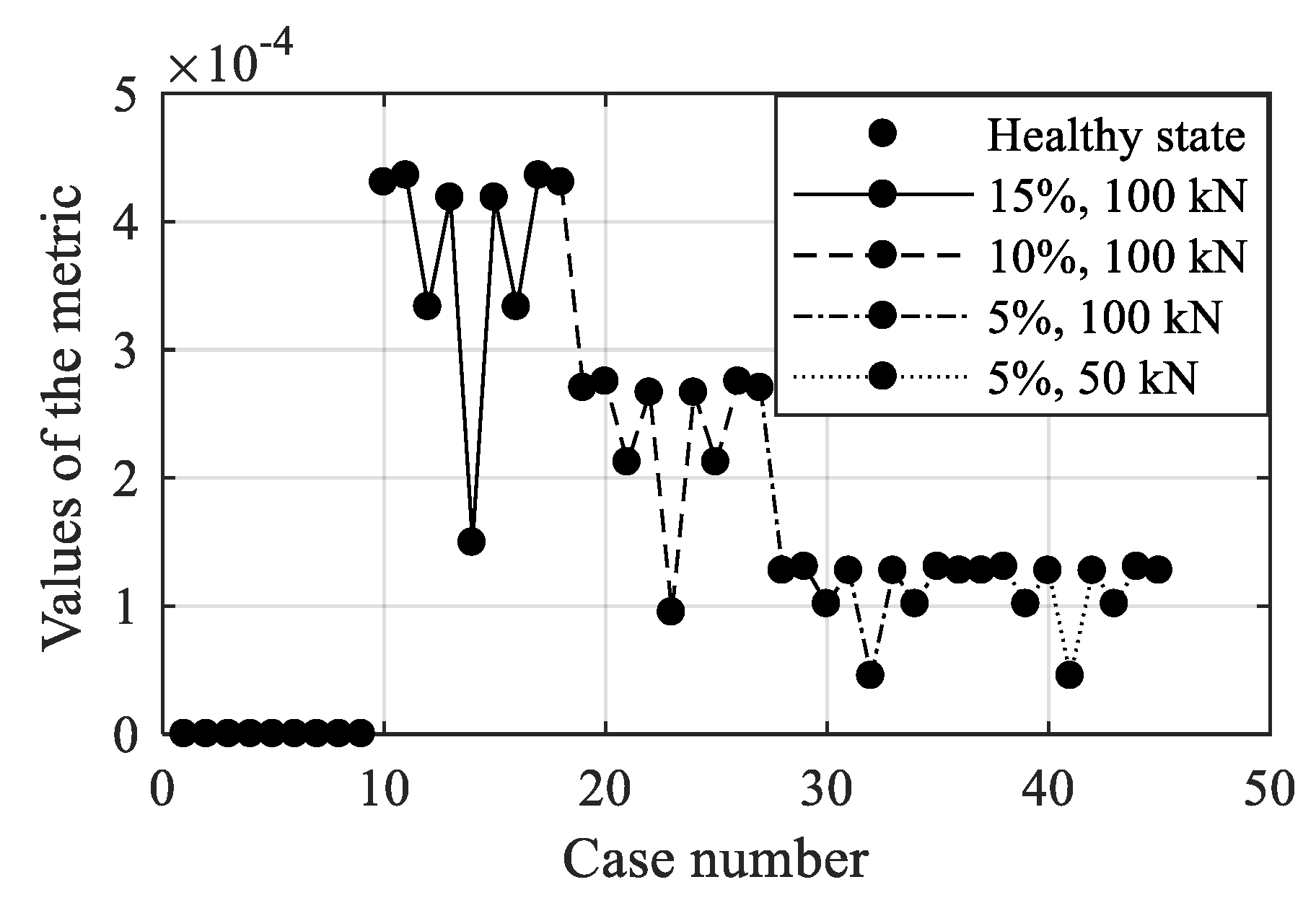
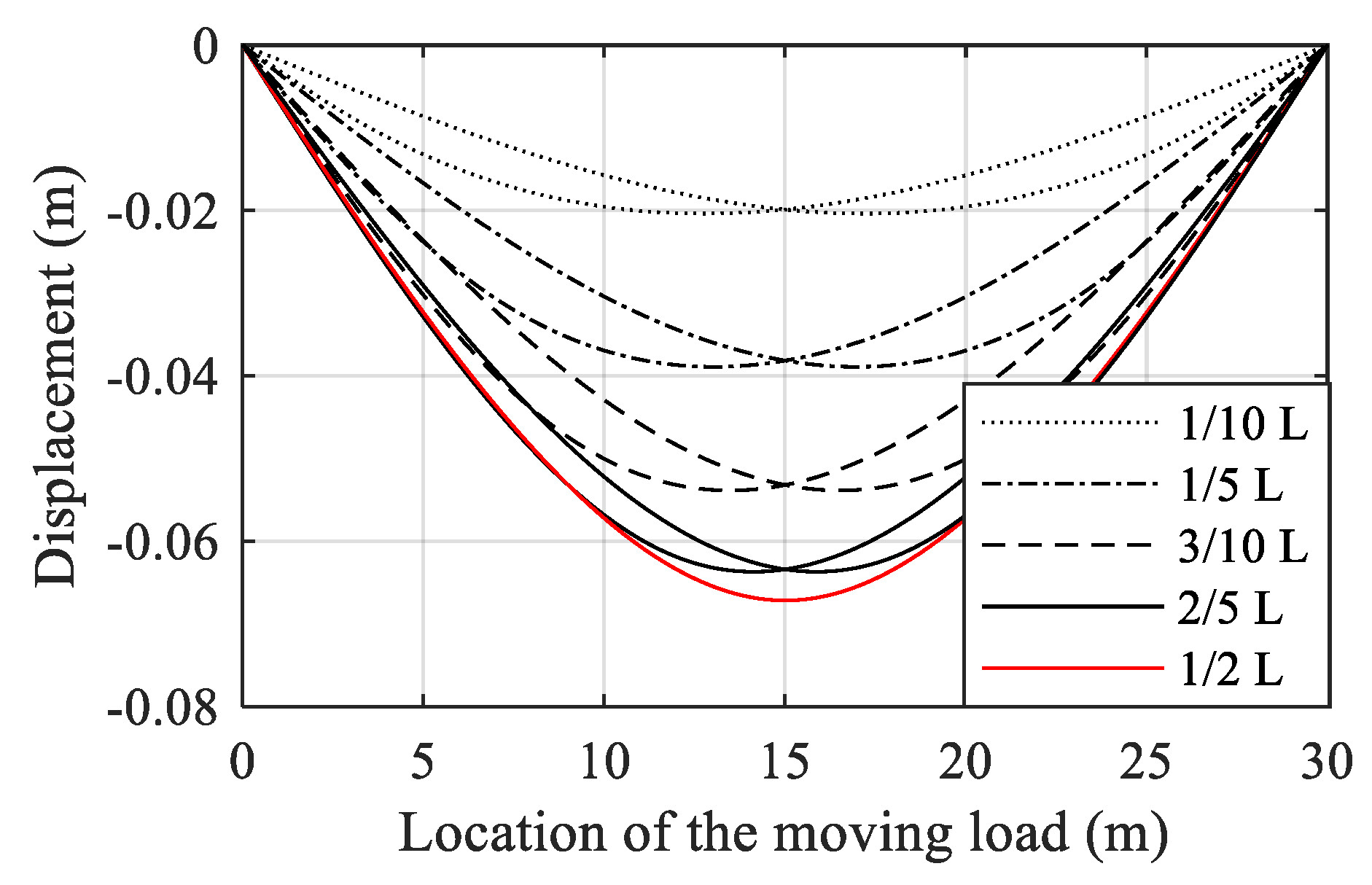
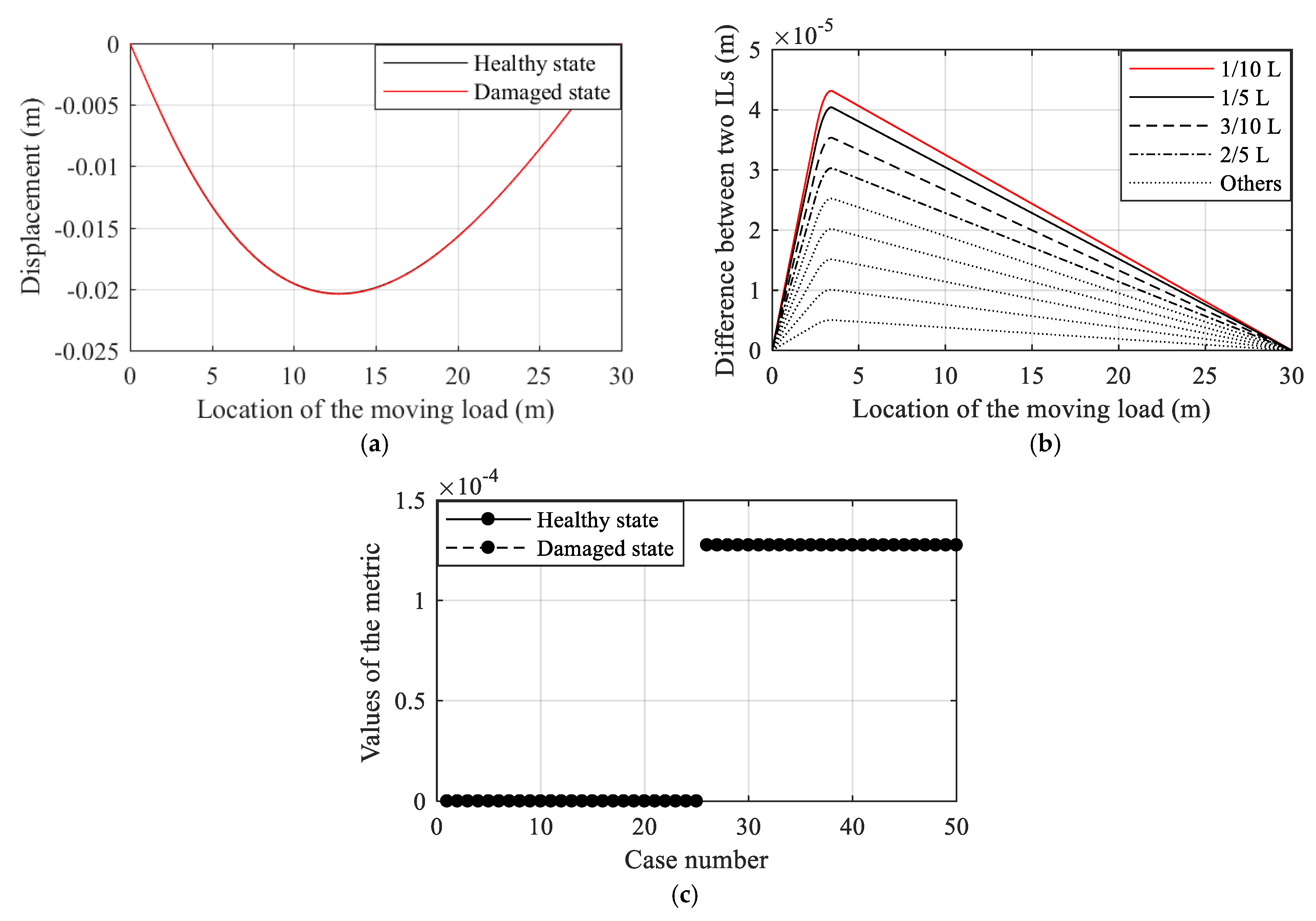
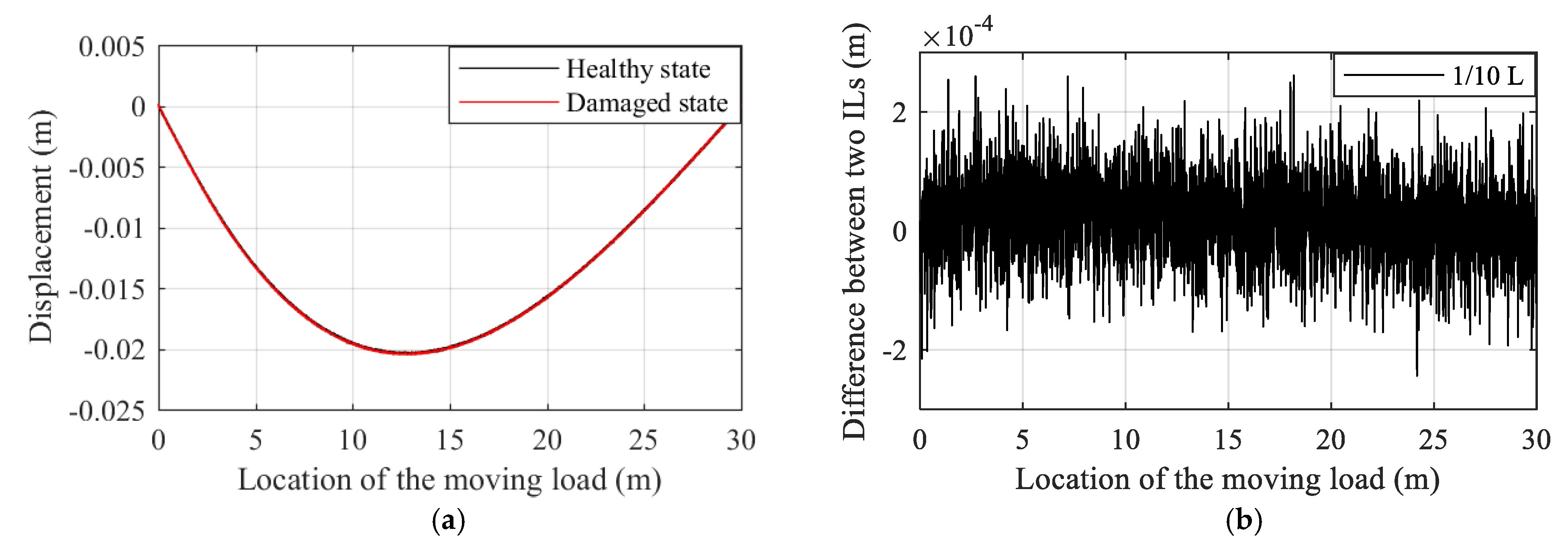
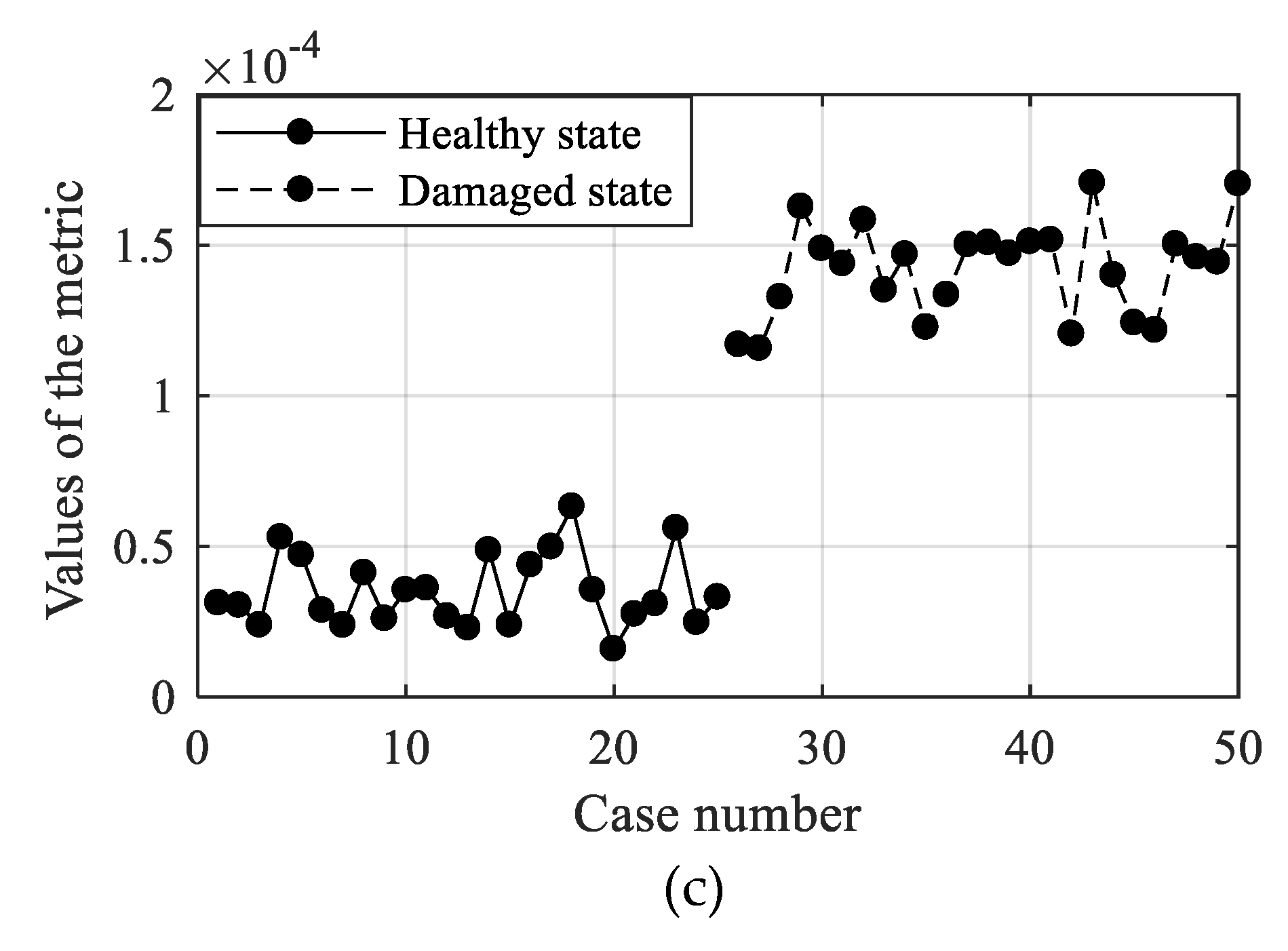
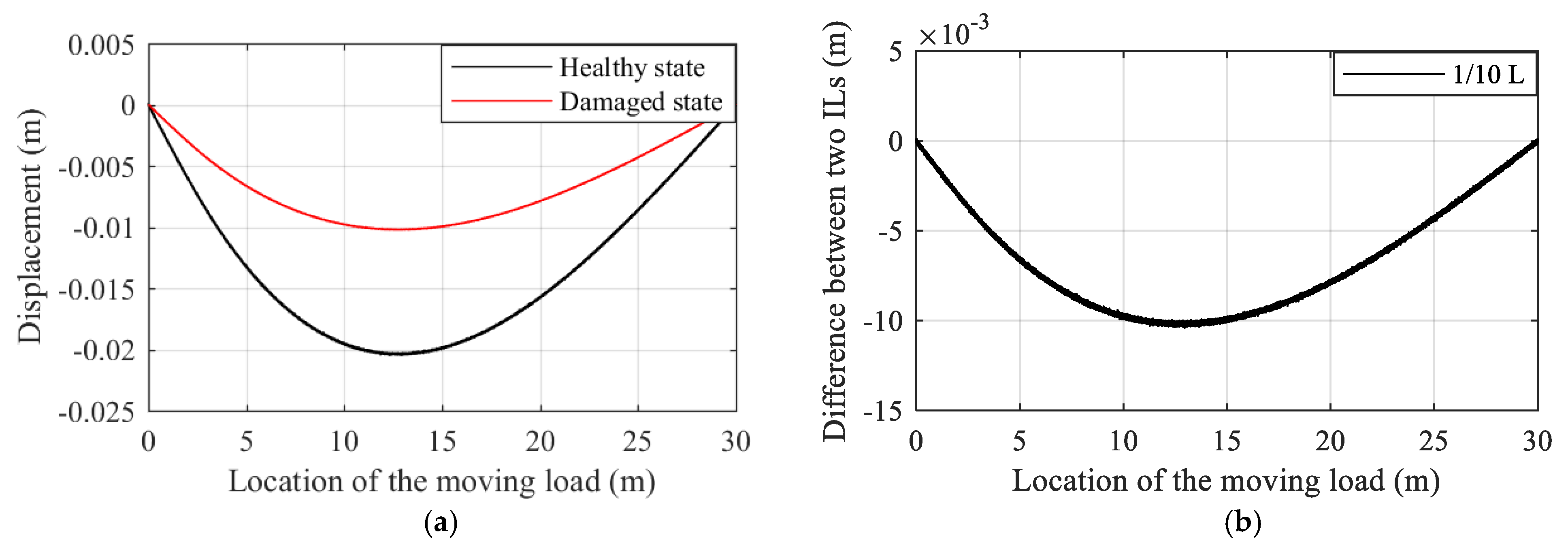
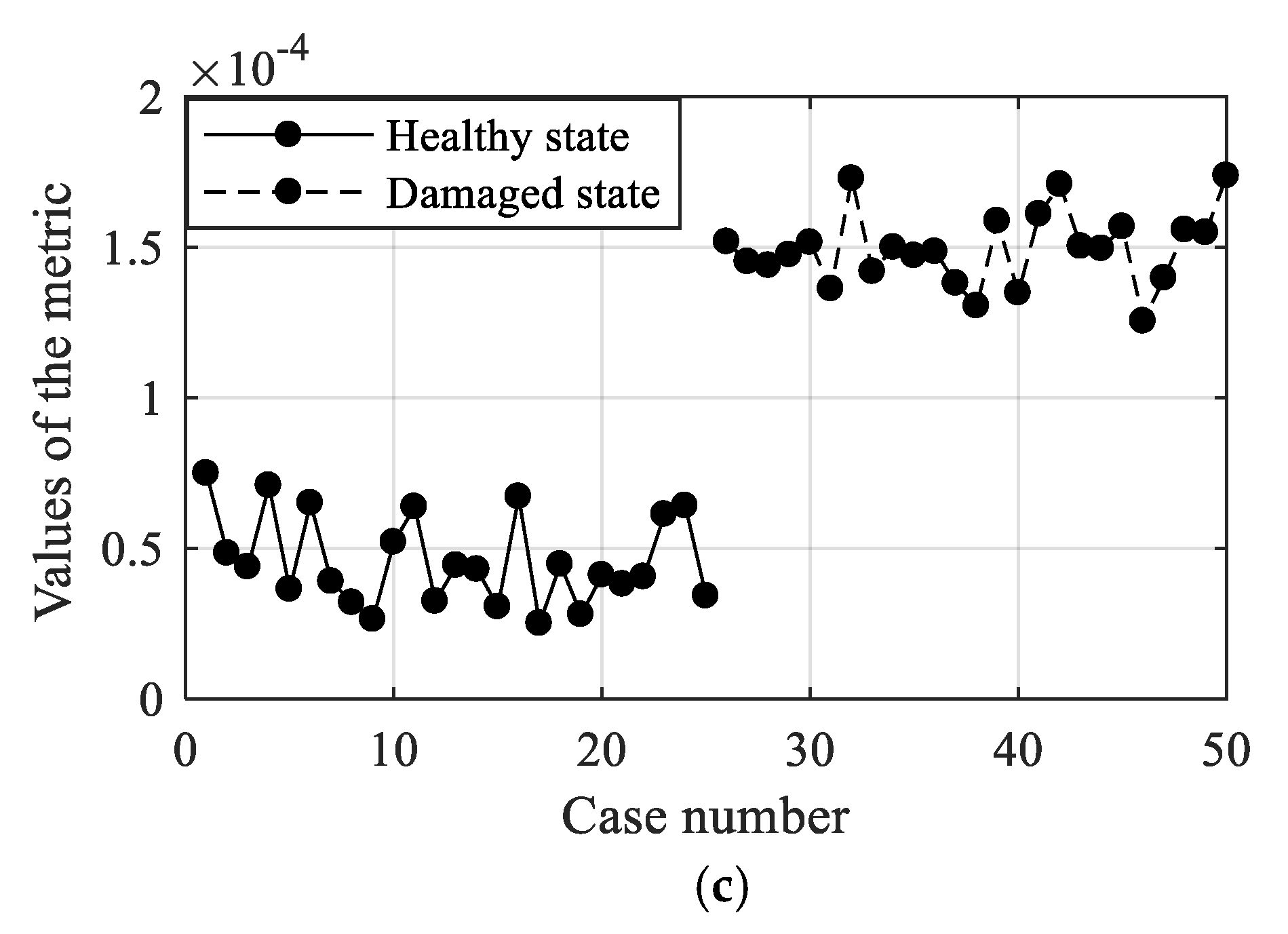


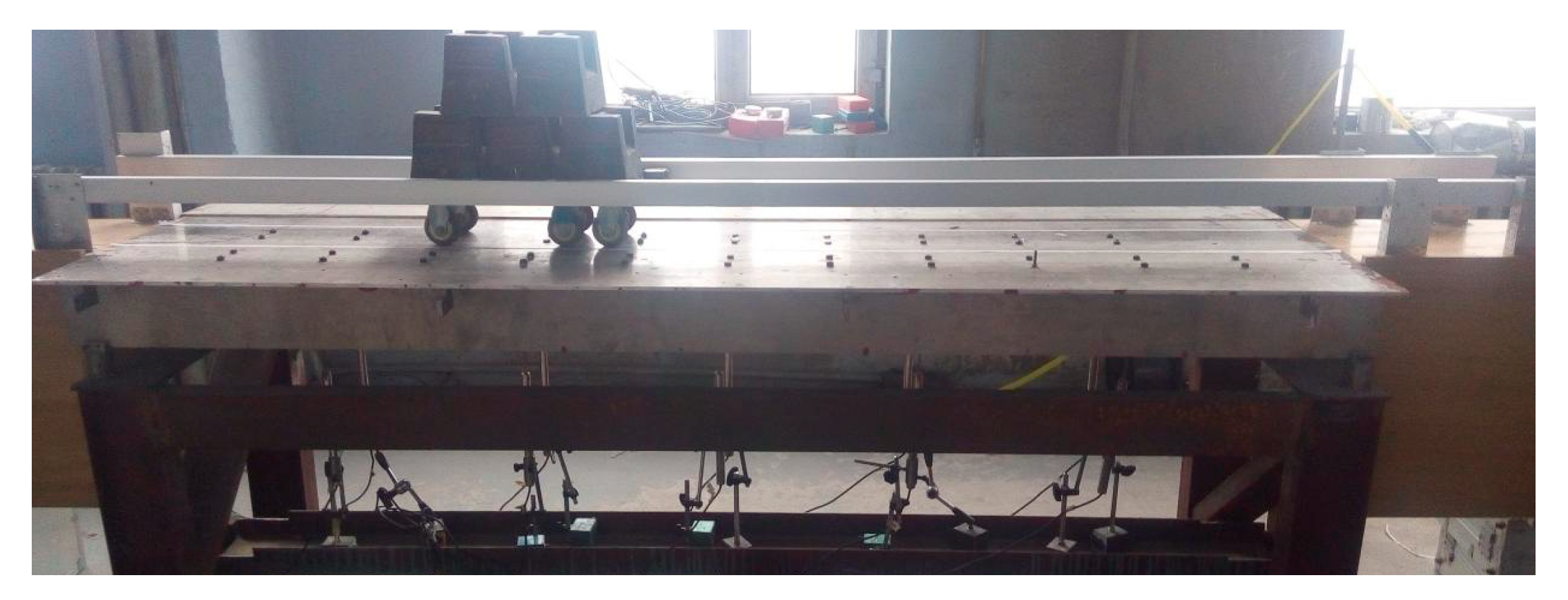

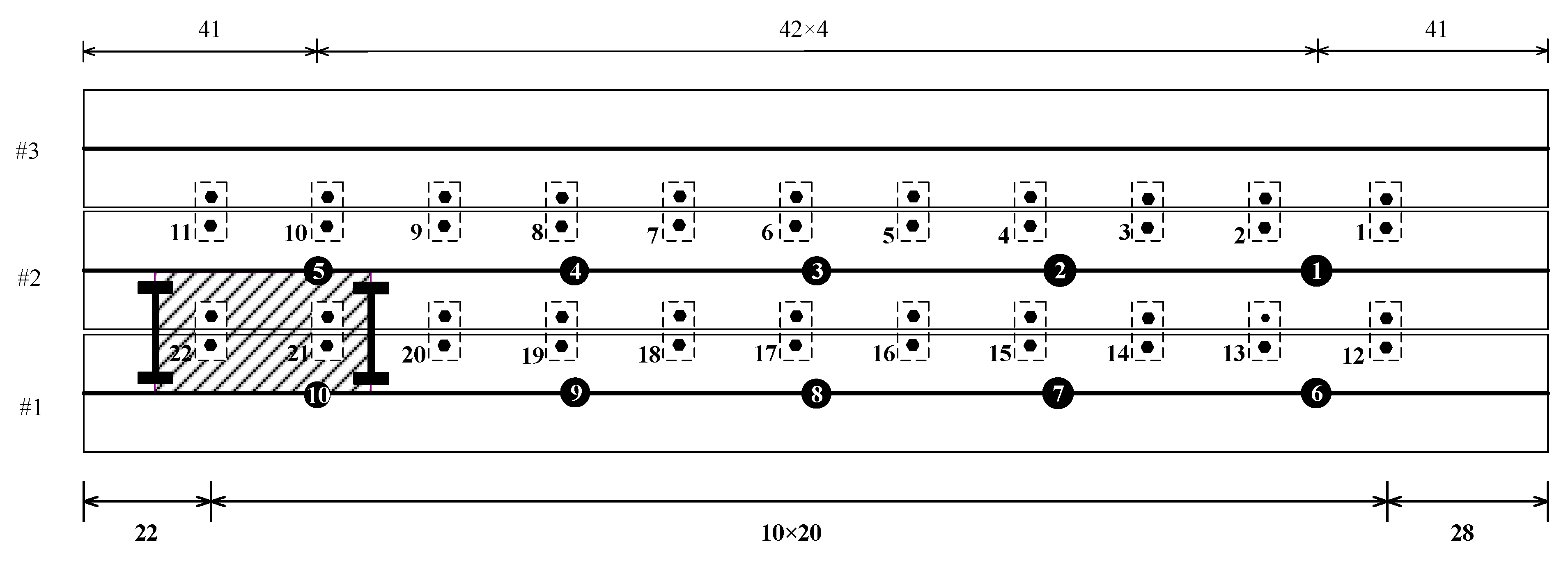
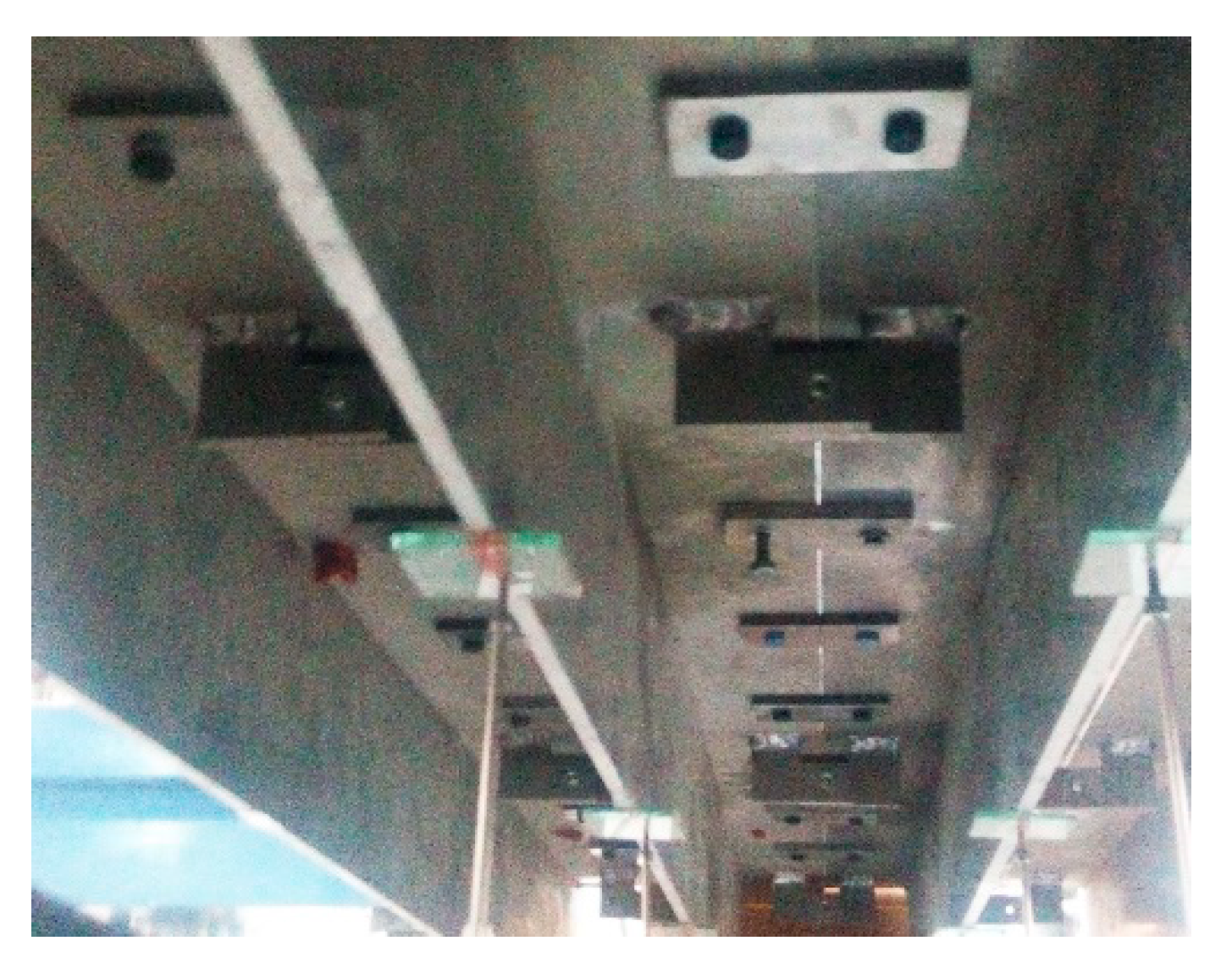

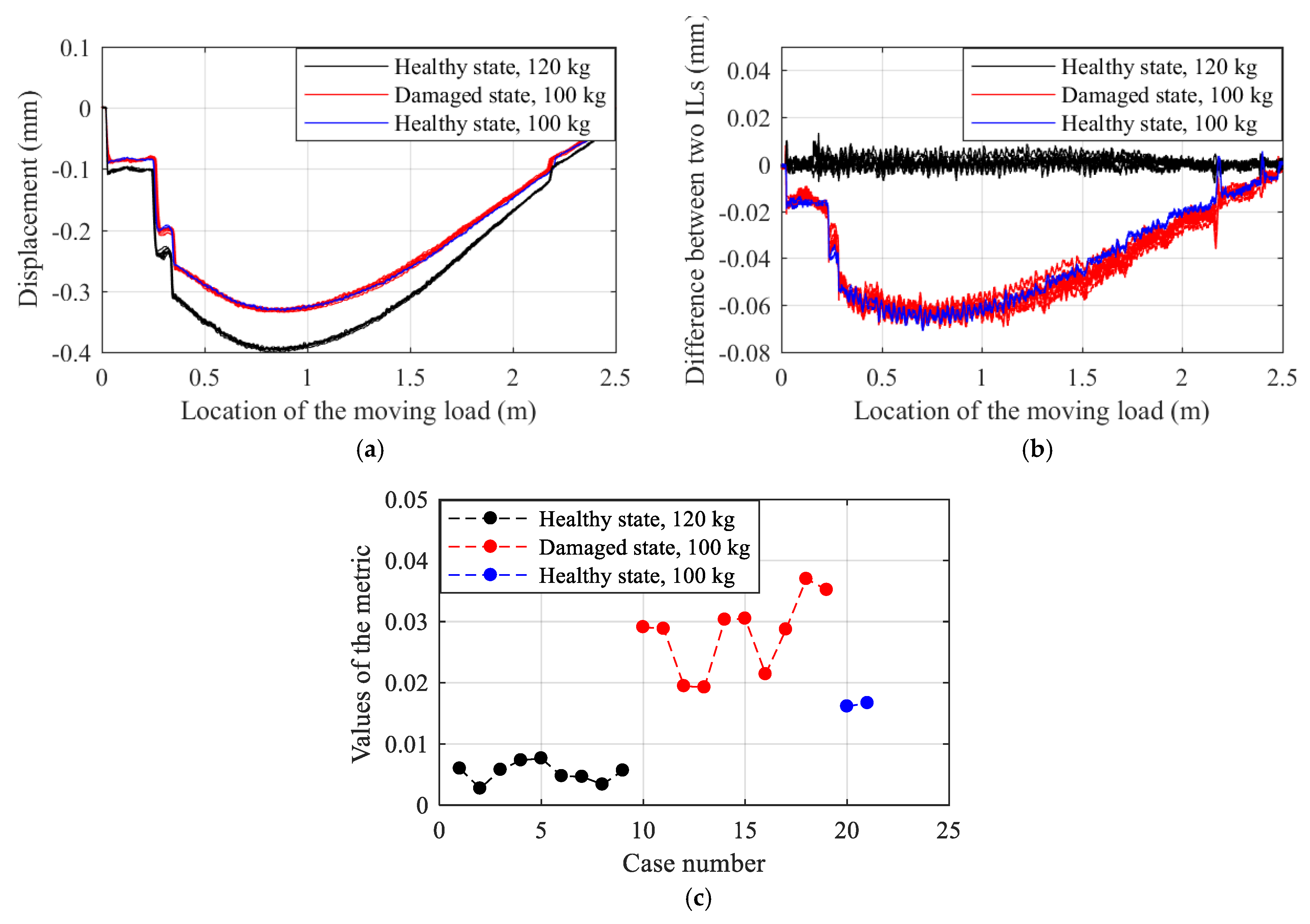
| Item | Young’s Modulus of C50 Concrete | Bending Moment of Inertia | Torsional Moment of Inertia |
|---|---|---|---|
| Value of parameter | 3.497 × 107 kN/m2 | 2.395 × 10−2 m4 | 4.353 × 10−2 m4 |
| Damage Location | Extent of Damage | Metric | Extent of Damage | Metric | Extent of Damage | Metric | Extent of Damage | Metric |
|---|---|---|---|---|---|---|---|---|
| 3 m | 0% | 9.992 × 10−16 | 15% | 4.306 × 10−4 | 10% | 2.701 × 10−4 | 5% | 1.275 × 10−4 |
| 6 m | 0% | 1.129 × 10−15 | 15% | 4.359 × 10−4 | 10% | 2.751 × 10−4 | 5% | 1.305 × 10−4 |
| 9 m | 0% | 1.073 × 10−15 | 15% | 3.333 × 10−4 | 10% | 2.121 × 10−4 | 5% | 1.015 × 10−4 |
| 12 m | 0% | 1.415 × 10−15 | 15% | 4.187 × 10−4 | 10% | 2.664 × 10−4 | 5% | 1.274 × 10−4 |
| 15 m | 0% | 1.169 × 10−15 | 15% | 1.494 × 10−4 | 10% | 9.497 × 10−5 | 5% | 4.538 × 10−5 |
| 18 m | 0% | 1.170 × 10−15 | 15% | 4.187 × 10−4 | 10% | 2.664 × 10−4 | 5% | 1.274 × 10−4 |
| 21 m | 0% | 1.104 × 10−15 | 15% | 3.333 × 10−4 | 10% | 2.121 × 10−4 | 5% | 1.015 × 10−4 |
| 24 m | 0% | 1.160 × 10−15 | 15% | 4.359 × 10−4 | 10% | 2.751 × 10−4 | 5% | 1.305 × 10−4 |
| 27 m | 0% | 1.228 × 10−15 | 15% | 4.306 × 10−4 | 10% | 2.701 × 10−4 | 5% | 1.275 × 10−4 |
| Case Conditions | Case Results | ||||||||||
|---|---|---|---|---|---|---|---|---|---|---|---|
| Damage extent | 5% | 5% | 5% | 5% | 5% | 5% | 5% | 5% | 5% | 5% | 5% |
| Noise level | 1.2% | 1.6% | 2.0% | 2.4% | 2.8% | 3.2% | 3.6% | 4.0% | 4.4% | 4.8% | 5.2% |
| Traditional method | Yes | No | No | No | No | No | No | No | No | No | No |
| Proposed method | Yes | Yes | Yes | Yes | Yes | Yes | Yes | Yes | Yes | Yes | No |
| Extent of damage | 10% | 10% | 10% | 10% | 10% | 10% | 10% | 10% | 10% | 10% | 10% |
| Noise level | 2.4% | 3.2% | 4.0% | 4.8% | 5.6% | 6.4% | 7.2% | 8.0% | 8.8% | 9.6% | 10.4% |
| Traditional method | Yes | No | No | No | No | No | No | No | No | No | No |
| Proposed method | Yes | Yes | Yes | Yes | Yes | Yes | Yes | Yes | Yes | Yes | No |
| Extent of damage | 15% | 15% | 15% | 15% | 15% | 15% | 15% | 15% | 15% | 15% | 15% |
| Noise level | 3.6% | 4.8% | 6.0% | 7.2% | 8.4% | 9.6% | 10.4% | 12.0% | 13.2% | 14.4% | 15.6% |
| Traditional method | Yes | No | No | No | No | No | No | No | No | No | No |
| Proposed method | Yes | Yes | Yes | Yes | Yes | Yes | Yes | Yes | Yes | Yes | No |
| Case Number | Description of Case | Case Number | Description of Case | Case Number | Description of Case |
|---|---|---|---|---|---|
| Case 1 | Healthy bridge; 120 kg moving vehicle | Case 13 ~ Case 14 | Remove #4 transverse connection; 120 kg moving vehicle | Case 19 ~ Case 20 | Remove #10 transverse connection; 120 kg moving vehicle |
| Case 2 ~ Case 10 | Healthy bridge; 120 kg moving vehicle | Case 15 ~ Case 16 | Remove #6 transverse connection; 120 kg moving vehicle | Case 21 ~ Case 30 | Repeat cases 11-20; 100 kg moving vehicle |
| Case 11 ~ Case 12 | Remove #2 transverse connection; 120 kg moving vehicle | Case 17 ~ Case 18 | Remove #8 transverse connection; 120 kg moving vehicle | Case 31 ~ Case 32 | Healthy bridge; 100 kg moving vehicle |
© 2019 by the authors. Licensee MDPI, Basel, Switzerland. This article is an open access article distributed under the terms and conditions of the Creative Commons Attribution (CC BY) license (http://creativecommons.org/licenses/by/4.0/).
Share and Cite
Zhang, S.; Liu, Y. Damage Detection in Beam Bridges Using Quasi-static Displacement Influence Lines. Appl. Sci. 2019, 9, 1805. https://doi.org/10.3390/app9091805
Zhang S, Liu Y. Damage Detection in Beam Bridges Using Quasi-static Displacement Influence Lines. Applied Sciences. 2019; 9(9):1805. https://doi.org/10.3390/app9091805
Chicago/Turabian StyleZhang, Shaoyi, and Yang Liu. 2019. "Damage Detection in Beam Bridges Using Quasi-static Displacement Influence Lines" Applied Sciences 9, no. 9: 1805. https://doi.org/10.3390/app9091805
APA StyleZhang, S., & Liu, Y. (2019). Damage Detection in Beam Bridges Using Quasi-static Displacement Influence Lines. Applied Sciences, 9(9), 1805. https://doi.org/10.3390/app9091805






